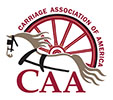Serial No. 1808
F & R Shanks
London
1907
Type:
Road coach is the term used in England for stage coaches running on a scheduled service and carrying fare-paying passengers. This name first came into use during the 1860s at the time of the so-called “coaching revival.” Coaching enthusiasts, sometimes on their own account and sometimes as syndicates, put coaches on the roads running out of London in the summer months to some resort or beauty spot. Usually a coaching professional managed the operation, and the amateur owner or syndicate provided the finance and covered any loss. Amateurs were in this way able to enjoy driving a coach in the old “down the road” tradition. Road coaches were built for the purpose, and were similar in design to the park drags used by members of the coaching clubs, but of heavier build.Road coach “Nimrod” by Shanks
Provenance:
The Nimrod coach was built by Shanks to the order of Miss Sylvia Brocklebank, who wanted to compete in a “Quick Change” competition at the International Horse Show at Olympia, London, in June, 1908. It then carried the name Wonder. Miss Brocklebank and her crew practised the change almost daily for a few weeks before the show, with the result that she won on the day with a good margin of time, beating several well-known professional coachmen.
Miss Brocklebank gave up coaching about 1920, and in 1928 she sold the Nimrod to Claude F. Goddard and H.J. Colebrook, who intended to run a coach service from London to Oxford. Claude Goddard owned the Tally-Ho! coach, and Miss Brocklebank’s coach was bought to serve as the spare. It was repainted, the name was changed from Wonder to Tally-Ho!, and figures of a fox and hounds were painted on the door panels by Cecil Aldin, a noted sporting artist. When the run ended and the partnership was dissolved, H.J. Colebrook became the owner of the Brocklebank coach, which he now named the Nimrod. Mr. Colebrook competed regularly during the 1930s wherever there were classes for road coaches, using a team of big chestnut Hackneys bred on Winnold Fen in Norfolk by Joseph Morton. The Nimrod was occasionally driven successfully by Mr. Colebrook’s daughter, Josephine, who, along with Miss Brocklebank, must be ranked among the best lady drivers of the 20th century.
In 1956, Mr. Colebrook sold his coach to Ben W. Colburn of California through the agency of Charles Gilbert, Jr., of Toronto, and it was bought by Mr. Seabrook in 1961. The coach had suffered in the ownership of Mr. Colburn through being left standing in the California sunshine. Several panels were split and the wheels were no longer safe to use. Mr. Seabrook had the wheels repaired and repainted, but he was reluctant to have anything done to the body panels for fear of damaging the Aldin paintings. In 1972 the decision was made to repair and paint the coach completely. The problem of the paintings was solved by having them copied on new panels by Aaron Shikler, a well-known New York artist. More recently, brakes have been fitted to the front wheels in such a way that the original structure of the coach is in no way changed. Mr. Seabrook has donated the old panels with the original Cecil Aldin figures to the British Sporting Art Trust for display in their gallery in Newmarket, England.
Builder:
Refer to the description of the Shanks mail phaeton.

